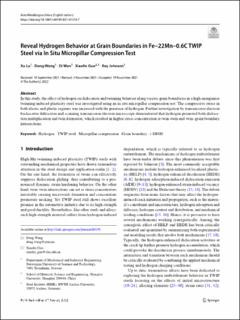| dc.contributor.author | Lu, Xu | |
| dc.contributor.author | Wang, Dong | |
| dc.contributor.author | Wan, Di | |
| dc.contributor.author | Guo, Xiaofei | |
| dc.contributor.author | Johnsen, Roy | |
| dc.date.accessioned | 2022-03-18T07:43:09Z | |
| dc.date.available | 2022-03-18T07:43:09Z | |
| dc.date.created | 2021-11-24T12:45:44Z | |
| dc.date.issued | 2022 | |
| dc.identifier.issn | 1006-7191 | |
| dc.identifier.uri | https://hdl.handle.net/11250/2986013 | |
| dc.description.abstract | In this study, the effect of hydrogen on dislocation and twinning behavior along various grain boundaries in a high-manganese twinning-induced plasticity steel was investigated using an in situ micropillar compression test. The compressive stress in both elastic and plastic regimes was increased with the presence of hydrogen. Further investigation by transmission electron backscatter diffraction and scanning transmission electron microscope demonstrated that hydrogen promoted both dislocation multiplication and twin formation, which resulted in higher stress concentration at twin–twin and twin–grain boundary intersections. | en_US |
| dc.language.iso | eng | en_US |
| dc.publisher | Springer | en_US |
| dc.rights | Navngivelse 4.0 Internasjonal | * |
| dc.rights.uri | http://creativecommons.org/licenses/by/4.0/deed.no | * |
| dc.title | Reveal hydrogen behavior at grain boundaries in Fe-22Mn-0.6C TWIP steel via in-situ micropillar compression test | en_US |
| dc.type | Peer reviewed | en_US |
| dc.type | Journal article | en_US |
| dc.description.version | publishedVersion | en_US |
| dc.source.journal | Acta Metallurgica Sinica (English Letters) | en_US |
| dc.identifier.doi | 10.1007/s40195-021-01370-7 | |
| dc.identifier.cristin | 1958367 | |
| dc.relation.project | Norges forskningsråd: 295864 | en_US |
| cristin.ispublished | true | |
| cristin.fulltext | original | |
| cristin.qualitycode | 0 | |

